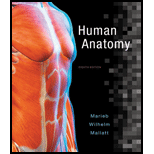
Human Anatomy (8th Edition)
8th Edition
ISBN: 9780134243818
Author: Elaine N. Marieb, Patricia Brady Wilhelm, Jon B. Mallatt
Publisher: PEARSON
expand_more
expand_more
format_list_bulleted
Textbook Question
Chapter 19, Problem 6CRCAQ
Another patient had an abnormal heart sound that indicated a stenotic valve. Define this condition, and contrast it with an incompetent heart valve.
Expert Solution & Answer
Want to see the full answer?
Check out a sample textbook solution
Students have asked these similar questions
Briefly state the physical meaning of the electrocapillary equation (Lippman equation).
Explain in a small summary how:
What genetic information can be obtained from a Punnet square? What genetic information cannot be determined from a Punnet square?
Why might a Punnet Square be beneficial to understanding genetics/inheritance?
In a small summary write down:
Chapter 19 Solutions
Human Anatomy (8th Edition)
Ch. 19 - Prob. 1CYUCh. 19 - Prob. 2CYUCh. 19 - What is another name for the epicardium?Ch. 19 - Identify the heart chamber or chambers that...Ch. 19 - Prob. 5CYUCh. 19 - Prob. 6CYUCh. 19 - During ventricular systole, are the AV valves open...Ch. 19 - Differentiate a stenotic valve from an incompetent...Ch. 19 - What is the significance of the gap junctions in...Ch. 19 - What is the pacemaker of the heart, and where is...
Ch. 19 - Prob. 11CYUCh. 19 - Prob. 12CYUCh. 19 - Prob. 13CYUCh. 19 - How would incomplete formation of the...Ch. 19 - Which chamber of the heart is formed from the...Ch. 19 - What is the single most important factor for...Ch. 19 - The most external part of the pericardium is the...Ch. 19 - Prob. 2RQCh. 19 - How many cusps does the right atrioventricular...Ch. 19 - Prob. 4RQCh. 19 - Prob. 5RQCh. 19 - Prob. 6RQCh. 19 - Prob. 7RQCh. 19 - Prob. 8RQCh. 19 - Prob. 9RQCh. 19 - Which layer of the heart wall is the thickest? (a)...Ch. 19 - The inferior left corner of the heart is located...Ch. 19 - Prob. 12RQCh. 19 - Describe the location of the heart within the...Ch. 19 - Trace a drop of blood through all the heart...Ch. 19 - Prob. 15RQCh. 19 - Sketch the heart and draw all the coronary vessels...Ch. 19 - Prob. 17RQCh. 19 - Prob. 18RQCh. 19 - Make a drawing of the adult heart and the...Ch. 19 - How do the right and left ventricles differ...Ch. 19 - Which is more resistant to fatigue, cardiac muscle...Ch. 19 - Describe the structure and function of an...Ch. 19 - Compare and contrast the structure of cardiac...Ch. 19 - Classify the three congenital heart...Ch. 19 - Prob. 2CRCAQCh. 19 - Prob. 3CRCAQCh. 19 - After a man was stabbed in the chest, his face...Ch. 19 - A heroin addict felt tired, weak, and feverish....Ch. 19 - Another patient had an abnormal heart sound that...Ch. 19 - Prob. 7CRCAQCh. 19 - During a lethal heart attack, a blood. clot lodges...Ch. 19 - Prob. 9CRCAQ
Knowledge Booster
Learn more about
Need a deep-dive on the concept behind this application? Look no further. Learn more about this topic, biology and related others by exploring similar questions and additional content below.Similar questions
- Not part of a graded assignment, from a past midtermarrow_forwardNoggin mutation: The mouse, one of the phenotypic consequences of Noggin mutationis mispatterning of the spinal cord, in the posterior region of the mouse embryo, suchthat in the hindlimb region the more ventral fates are lost, and the dorsal Pax3 domain isexpanded. (this experiment is not in the lectures).a. Hypothesis for why: What would be your hypothesis for why the ventral fatesare lost and dorsal fates expanded? Include in your answer the words notochord,BMP, SHH and either (or both of) surface ectoderm or lateral plate mesodermarrow_forwardNot part of a graded assignment, from a past midtermarrow_forward
- Explain in a flowcharts organazing the words down below: genetics Chromosomes Inheritance DNA & Genes Mutations Proteinsarrow_forwardplease helparrow_forwardWhat does the heavy dark line along collecting duct tell us about water reabsorption in this individual at this time? What does the heavy dark line along collecting duct tell us about ADH secretion in this individual at this time?arrow_forward
arrow_back_ios
SEE MORE QUESTIONS
arrow_forward_ios
Recommended textbooks for you
 Medical Terminology for Health Professions, Spira...Health & NutritionISBN:9781305634350Author:Ann Ehrlich, Carol L. Schroeder, Laura Ehrlich, Katrina A. SchroederPublisher:Cengage LearningUnderstanding Health Insurance: A Guide to Billin...Health & NutritionISBN:9781337679480Author:GREENPublisher:Cengage
Medical Terminology for Health Professions, Spira...Health & NutritionISBN:9781305634350Author:Ann Ehrlich, Carol L. Schroeder, Laura Ehrlich, Katrina A. SchroederPublisher:Cengage LearningUnderstanding Health Insurance: A Guide to Billin...Health & NutritionISBN:9781337679480Author:GREENPublisher:Cengage Fundamentals of Sectional Anatomy: An Imaging App...BiologyISBN:9781133960867Author:Denise L. LazoPublisher:Cengage Learning
Fundamentals of Sectional Anatomy: An Imaging App...BiologyISBN:9781133960867Author:Denise L. LazoPublisher:Cengage Learning Human Physiology: From Cells to Systems (MindTap ...BiologyISBN:9781285866932Author:Lauralee SherwoodPublisher:Cengage Learning
Human Physiology: From Cells to Systems (MindTap ...BiologyISBN:9781285866932Author:Lauralee SherwoodPublisher:Cengage Learning

Medical Terminology for Health Professions, Spira...
Health & Nutrition
ISBN:9781305634350
Author:Ann Ehrlich, Carol L. Schroeder, Laura Ehrlich, Katrina A. Schroeder
Publisher:Cengage Learning

Understanding Health Insurance: A Guide to Billin...
Health & Nutrition
ISBN:9781337679480
Author:GREEN
Publisher:Cengage

Fundamentals of Sectional Anatomy: An Imaging App...
Biology
ISBN:9781133960867
Author:Denise L. Lazo
Publisher:Cengage Learning



Human Physiology: From Cells to Systems (MindTap ...
Biology
ISBN:9781285866932
Author:Lauralee Sherwood
Publisher:Cengage Learning
Respiratory System; Author: Amoeba Sisters;https://www.youtube.com/watch?v=v_j-LD2YEqg;License: Standard youtube license